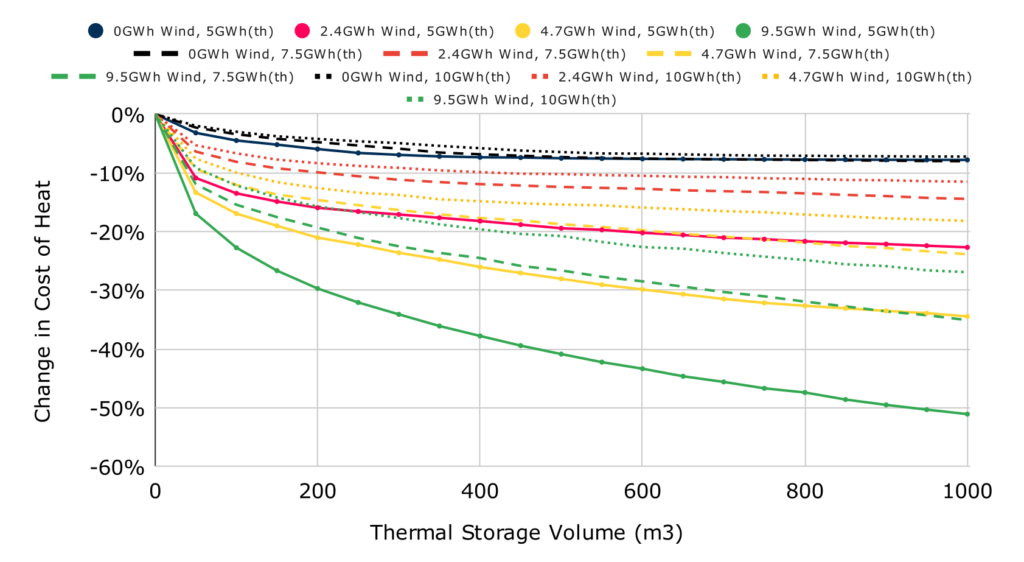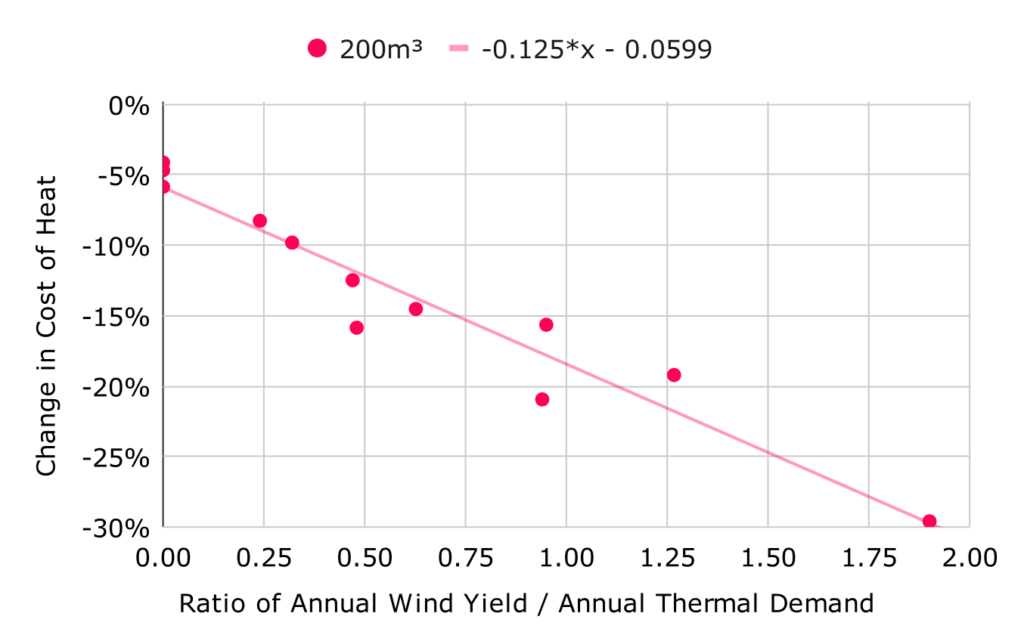Introduction
At a daily scale, wind and solar generation is intermittent and peaks in generation are not necessarily well aligned with peaks in network heat demand. Similarly, electricity suppliers offering flexible tariffs may sell electricity at a lower price when heat demand is low and is of little benefit to the heat network. Short term energy storage in the form of electrical (e.g. batteries) or thermal (e.g. hot water tanks) can provide a cost-benefit to a heat network by enabling energy to be stored when the cost of electricity is lower, and discharged into the network to meet demand when the cost of electricity is higher. A key benefit of a centralised district heat network over other network designs is that short term energy storage, in the form of large insulated hot water tanks, can be built into the system, which are a fraction of the cost of electrical batteries. Thermal storage also allows a smaller capacity heat source to be used to provide a larger proportion of the heat demand which, for renewable heat generation, can significantly reduce the capital costs.
There are a variety of software tools available (e.g. EnergyPro, PyLESA) to estimate and optimise the size of thermal storage that is used in a network. These generally involve running lengthy simulations which model a hot water tank being charged / discharged based on hourly generation and heat demand profiles. This is too computationally intensive an analysis to perform in the CHDU techno-economic model (TEM) given the TEM is to be used in a national site screening exercise. Instead, a more generalised method must be developed. This article describes how the cost-benefit of hot water tanks is built into the CHDU TEM.
Analysis of Thermal Storage Benefits
The benefits of thermal storage on the finances of an air source heat pump (ASHP) heated heat network including local renewable energy generation have been assessed using PyLESA. PyLESA (Python for Local Energy Systems Analysis, https://github.com/andrewlyden/PyLESA) is an open source modelling tool for the planning-level design of local energy systems and is described in more detail in the Thermal Demand Profiles article. PyLESA is useful for modelling the effect of storage on the cost of supplying heat to a network since it includes a control algorithm which uses hourly renewable generation and heat demand profiles to determine the hourly charging / discharging of a hot water tank, optimised to reduce the cost of delivering heat. PyLESA allows for different size heat pumps to be assessed along with different hot water tank volumes enabling optimisation of the heat pump size.
Twelve PyLESA simulations were run using a network of 200 domestic buildings with heat provided by ASHPs powered by a mixture of grid electricity and wind turbines connected via private wire. The hourly wind generation and heat demand profile shapes used in the CHDU TEM were input into PyLESA and a dual day/night (26/21 p/kWh) tariff was defined for purchasing grid electricity. For each simulation, the results were reviewed using the heat pump which provided the lowest levelised cost of heat, and hence was best sized for the network.
Figure 1 presents the change in cost of heat for each of the twelve different combinations of annual wind energy generation and annual thermal demand, plotted against different thermal storage volumes. The cost of heat calculated by PyLESA is a measure of how much grid electricity must be bought at a given unit price, to meet the heat demand of the network, and does not include consideration of the capital costs of thermal storage. The capital costs of thermal storage are considered separately in the TEM. The change in cost of heat is calculated by comparing the cost of heat in a network which includes thermal storage to the cost of heat with no thermal storage.

The cost of heat calculated by PyLESA decreases with storage volume. This is as expected since thermal storage allows for heat to be generated when electricity is cheaper rather than solely when it is required. The reduction in the cost of heat is most pronounced at small storage volumes, with the increase in benefit diminishing as the storage volumes get larger. Comparing the change in cost of heat for simulations with different annual wind yields and annual thermal demands indicates that the benefit of thermal storage is directly related to the ratio of wind generation to thermal demand i.e. the more wind energy available, the greater the benefit of thermal storage.
How is Thermal Storage Used
The benefit of including thermal storage in the network is modelled as a reduction in the cost of heat generation. Specifically, this is modelled as a percentage reduction in imported grid electricity. A thermal storage volume of 200m3 is assumed within the CHDU TEM beyond which the cost-benefit of thermal storage reduces for the typical network sizes considered by the CHDU. The percentage reduction in the cost of heat for a specific network site is estimated using the linear relationship for a 200m3 hot water tank presented in Figure 2.

The horizontal axis in Figure 2 is the ratio of annual wind yield at a specific network site to the annual thermal demand of the buildings connected to the network. The vertical axis is the change in cost of supplying heat in the network which is directly proportional to the amount of grid purchased electricity.
The relationship presented in Figure 2 suggests that the change in cost of heat is proportional to the ratio between annual wind yield and annual thermal demand. This is as expected since more self consumption of on-site generation by the heat pumps means less grid electricity needs to be purchased. This relationship is built into the CHDU TEM so the benefit of thermal storage can be estimated for each assessed site.
The thermal storage is also modelled as having a capital cost. Specifics of these costs are discussed in the dedicated CAPEX costs article on this website.
There are a couple of notable exclusions from the thermal storage model including the CHDU TEM:
- Longer term storage which stores energy for use across a year, known as seasonal storage, is not considered.
- There is no consideration of how thermal storage may reduce the peak demand and hence reduce the heat pump size. This is conservative because it is likely that thermal storage will enable a smaller heat pump to be used to heat the network.
References
EnergyPro, https://www.emd-international.com/energypro/
PyLESA: https://www.softxjournal.com/article/S2352-7110(21)00044-3/fulltext
Banner Image Attribution:
Image cropped from original image available at segenergy.dk. Usage is kindly permitted by Morten Pipper of SEG A/S.